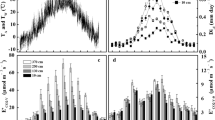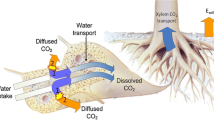Abstract
The accurate assessment of actual tree stem respiration and its relation with temperature plays a considerable role in investigating the forest carbon cycle. An increasing number of research reports have indicated that tree stem respiration determined with the commonlyapplied chamber gas exchange measuring system does not follow expectations regarding temperature relationships. This method is based on the nowadays widely-accepted theory that the respired CO2 in a tree stem would all diffuse outward into the atmosphere. However, it neglects partial CO2 that is dissolved in the xylem sap and is carried away by the transpirational stream. Scientists have started to realize that the respired CO2 measured with the chamber gas exchange method is only a portion of the total stem respiration (CO2 efflux), while the other portion, which is sometimes very substantial in quantity (thought to occupy maybe 15%–75% of the total stem respiration), is transported to the upper part of the stem and to the canopy by sap flow. This suggests that the CO2 produced by respiration is re-allocated within the stem. Accordingly, the change in CO2 efflux could be reflected in the rates of sap flow in addition to its dependence on temperature. Proper methods and instruments are required to quantify the internal and external CO2 fluxes in the trunk and their interaction with related environmental factors.
Similar content being viewed by others
References
Amthor J S (1989). Respiration and crop productivity. New York: Springer-Verlag
Barbour M M, Whitehead D (2003). A demonstration of the theoretical prediction that sap velocity is related to wood density in the conifer, Dacrydium cupressinum (rimu). New Phytologist, 158: 477–488
Bowman W P, Barbour M M, Turnbull M H, Tissue D T, Whitehead D, Griffin K (2005). Sap flow rates and sapwood density are critical factors in within- and between-tree variation in CO2 efflux from stems of mature Dacrydium cupressinum trees. New Phytologist, 167: 815–828
Campbell G S, Norman J M (1998). An Introduction to Environmental Biophysics. New York: Springer-Verlag
Cavaleri M A, Oberbauer S T, Ryan M G (2006). Wood CO2 efflux in a primary tropical rain forest. Global Change Biology, 12: 2442–2458
Chambers J Q, Tribuzy E S, Toledo L C, Crispim B F, Higuchi N, Santos J D, Araújo A C, Kruijt B, Nobre A D, Trumbore S E (2004). Respiration from a tropical forest ecosystem: partitioning of sources and low carbon use efficiency. Ecological Applications, 14: S72–88
Damesin C, Ceschia E, Le Goff N, Ottorini J M, Dufrêne E (2002). Stem and branch respiration of beech: from tree measurements to estimation at the stand level. New Phytologist, 153: 159–172
Eklund L (1990). Endogenous levels of oxygen, carbon dioxide and ethylene in stems of Norway spruce trees during one growing season. Trees, 4: 150–154
Gansert D (2004). A new type of cuvette for the measurement of daily variation of CO2 efflux from stems and branches in controlled temperature conditions. Trees, 18: 221–229
Gansert D, Burgdorf M (2005). Effects of xylem sap flow on carbon dioxide efflux from stems of birch (Betula pendula Roth). Flora, 200: 444–455
Hari P, Nygren P, Korpilahti E (1991). Internal circulation of carbon dioxide within a tree. Canadian Journal of Forest Research, 21: 514–515
Janssens I A, Lankreijer H, Matteucci G Kowalski A S, Buchmann N, Epron D, Pilegaard K, Kutsch W, Longdoz B, Grünwald T, Montagnani L, Dore S, Rebmann C, Moors E J, Grelle A, Rannik Ü, Morgenstern K, Oltchev S, Clement R, Gudmundsson J, Minerbi S, Berbigier P, Ibrom A, Moncrieff J, Aubinet M, Bernhofer C, Jensen N O, Vesala T, Granier A, Schulze E D, Lindroth A, Dolman A J, Jarvis P G, Ceulemans R, Valentini R (2001). Productivity overshadows temperature in determining soil and ecosystem respiration across European forests. Global Change Biology, 7: 269–278
Kakubari Y (1988). Diurnal and seasonal fluctuations in the bark respiration of standing Fagus sylvatica trees at Solling, West Germany. Journal of Japanese Forest Society, 70: 64–70
Larcher W (2001). Ökophysiologie der Pflanzen. Stugttgart: Verlag Eugen Ulmer, 150–157
Lavigne M B (1987). Differences in stem respiration responses to temperature between balsam fir trees in thinned and unthinned stands. Tree Physiology, 3: 225–233
Lavigne M B, Franklin S E, Hunt E R Jr (1996). Estimating stem maintenance respiration rates for dissimilar balsam fir stands. Tree Physiology, 16: 687–695
Levy P E, Jarvis P G (1998). Stem CO2 fluxes in two Sahelian shrub species (Guiera senegalensis and Combretum micranthum). Functional Ecology, 1998, 12: 107–116
Levy P E, Meir P, Allen S J, Jarvis P G (1999). The effect of aqueous transport of CO2 in xylem sap on gas exchange in woody plants. Tree Physiology, 19: 53–58
Maier C A, Clinton B D (2006). Relationship between stem CO2 efflux, stem sap velocity and xylem CO2 concentration in young loblolly pine trees. Plant, Cell and Environment, 29: 1471–1483
Maier C A, Zarnoch S J, Dougherty P M (1998). Effects of temperature and tissue nitrogen on dormant seasonal stem and branch maintenance respiration in a young loblolly pine (Pinus taeda) plantation. Tree Physiology, 1998, 18: 11–20
Martin T A, Teskey R O, Dougherty P M (1994). Movement of respiratory CO2 in stems of loblolly pine (Pinus taeda L.) seedlings. Tree Physiology, 14: 481–495
McGuire M A, Teskey R O (2004). Estimating stem respiration in trees by a mass balance approach that accounts for internal and external fluxes of CO2. Tree Physiology, 24: 571–578
McGuire M A, Teskey R O, Cerasoli S (2007). CO2 fluxes and respiration of branch segments of sycamore (Platanus occidentalis L.) examined at different sap velocities, branch diameters, and temperatures. Journal of Experimental Botany, 58: 2159–2168
Meir P, Grace J (2002). Scaling relationships for woody tissue respiration in two tropical rain forests. Plant, Cell and Environment, 25: 963–973
Pfanz H, Aschan G (2001). The existence of bark and stem photosynthesis in woody plants and its significance for the overall carbon gain. An eco-physiological and ecological approach. Progress in Botany, 62: 477–510
Pruyn M L, Gartner B L, Harmon M E (2002). Within stem variation of respiration in Douglas fir trees. New Phytologist, 154: 359–372
Pruyn M L, Harmon M E, Gartner B L (2003). Stem respiratory potential in six softwood and four hardwood tree species in the central cascades of Oregon. Oecologia, 137: 10–21
Ryan M G, Gower S T, Hubbard R M, Waring R H, Gholz H L, Cropper W P, Running S W (1995). Woody tissue maintenance respiration of four conifers in contrasting climates. Oecologia, 101: 133–140
Ryan M G, Hubbard R M, Clark D A, Sanford R L (1994). Woody-tissue respiration for Simarouba amara and Minquartia guianensis, two tropical wet forest trees with different growth habits. Oecologia, 100: 213–220
Saveyn A, Steppe K, Lemeur R. Report on non-temperature related variations in CO2 efflux rates from young tree stems in the dormant season (2008). Trees, 22(2): 165–174
Stringer J W, Kimmerer T W (1993). Refixation of xylem sap CO2 in Populus deltoides. Physiol Plant, 89: 243–251
Teskey R O, McGuire M A (2002). Carbon dioxide transport in xylem causes errors in estimation of rates of respiration in stems and branches of trees. Plant, Cell and Environment, 25, 1571–1577
Teskey R O, McGuire M A (2005). CO2 transported in xylem sap affects CO2 efflux from Liquidambar styraciflua and Platanus occidentalis stems, and contributes to observed wound respiration phenomena. Trees, 19: 357–362
Wang M, Liu Y Q, Hao Z Q, Wang Y S (2006). Respiration rate of broadleaved Korean pine forest ecosystem in Changbai Mountains. Chinese Journal of Applied Ecology, 17(10): 1789–1795 (in Chinese)
Wang W J (2004). Methods for the determination of CO2 flux from nonphotosynthetic organs of trees and their influences on the results. Acta Ecologica Sinica, 24(9): 2056–2067
Wang W J, Wang H M, Zu Y G, Li X Y, Takayoshi K (2005). Characteristics of root, stem, and soil respiration Q10 temperature coefficients in forest ecosystems. Acta Phytoecologica Sinica, 29(4): 680–691 (in Chinese)
Wang W J, Yang F J, Zu Y G, Wang H M, Kentaro T, Kaichiro S, Takayoshi K (2003). Stem Respiration of a Larch (Larix gmelini) Plantation in Northeast China. Acta Botanica Sinica, 45(12): 1387–1397
Waring R H, Schlesinger W H (1985). Forest ecosystems: concepts and management. London: Academic Press
Xiao F M, Wang S L, Du T Z, Chen L C, Yu X J (2005). Respiration of Chinese fir in plantations in Huitong, Hu’nan Province. Acta Ecologica Sinica, 25(10): 2514–2519 (in Chinese)
Xu M, Debiase T A, Qi Y, Goldstein A, Liu Z (2001). Ecosystem respiration in a young ponderosa pine plantation in Sierra Nevada Mountains, California. Tree Physiology, 21: 309–318
Yan Y P, Sha L Q, Cao M (2008). Diurnal Variation of Stem Respiration of Three Tropical Tree Species in Xishuangbanna, Southwest China. Journal of Plant Ecology, 32(1): 23–30 (in Chinese)
Yoder B J, Ryan M G, Waring R H, Schoettle A W, Kaufmann M R (1994). Evidence of reduced photosynthetic rates in old trees. Forest Science, 40: 513–527
Zeng X P, Peng S L, Zhao P (2000). Measurement of respiration amount in artificial Acacia Mangium forest in a low subtropical hill forest region of Guangdong. Acta Phytoecologica Sinica, 24(2): 420–424 (in Chinese)
Zeng X P, Zhao P, Sun G C (2006). Effects of climate warming on terraneous plants. Chinese Journal of Applied Ecology, 17(12): 2445–2450 (in Chinese)
Zeng Z P (2007). Productivity, structure and function of 3 types of manmade forest communities in Heshan, South China. Guangzhou: PhD Dissertation of Graduate School of Chinese Academy of Sciences (in Chinese)
Zhao P, Lu P, Ma L, Sun G C, Rao X Q, Cai X A, Zeng X P (2005). Combining sap flow measurement-based canopy stomatal conductance and 13C discrimination to estimate forest carbon assimilation. Chinese Science Bulletin, 50(18): 2021–2027
Zhao P, Rao X Q, Ma L, Cai X A, Zeng X P (2006)a. Sap flow-scaled stand transpiration and canopy stomatal conductance in an Acacia mangium forest. Acta Phytoecologica Sinica, 30(4): 655–665
Zhao P, Rao X Q, Ma L, Cai X A, Zeng X P (2006)b. The variations of sap flux density and whole-tree transpiration across individuals of Acacia mangium. Acta Ecologica Sinica, 26(12): 4050–4058
Zhao X S, Guan D X, Wu J B, Zhang M, Jin C J, Han S J (2006)c. The relationship between CO2 flux and temperature of the mixed forest of broadleaved and Korean-Pine in Changbai Mountain. Acta Ecologica Sinica, 26(4): 1088–1095
Author information
Authors and Affiliations
Corresponding author
Rights and permissions
About this article
Cite this article
Zhao, P., Hölscher, D. The concentration and efflux of tree stem CO2 and the role of xylem sap flow. Front. Biol. China 4, 47–54 (2009). https://doi.org/10.1007/s11515-008-0106-y
Received:
Accepted:
Published:
Issue Date:
DOI: https://doi.org/10.1007/s11515-008-0106-y




